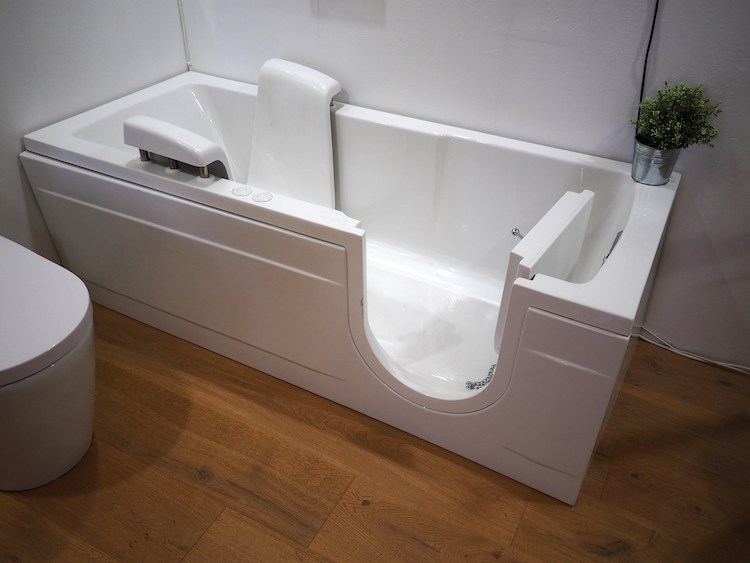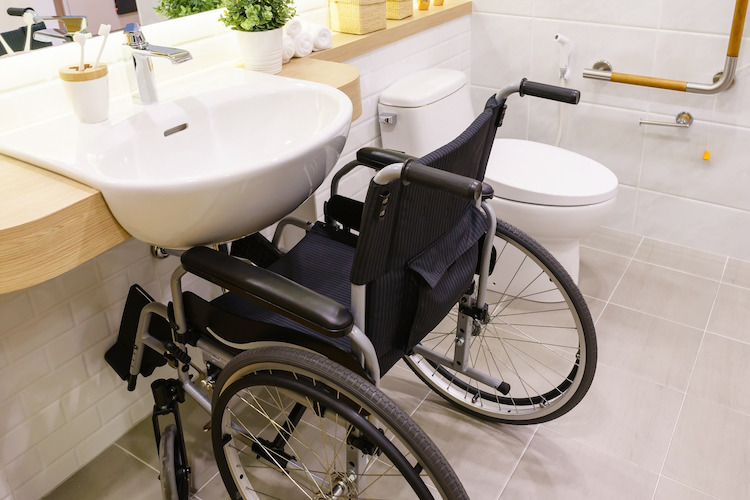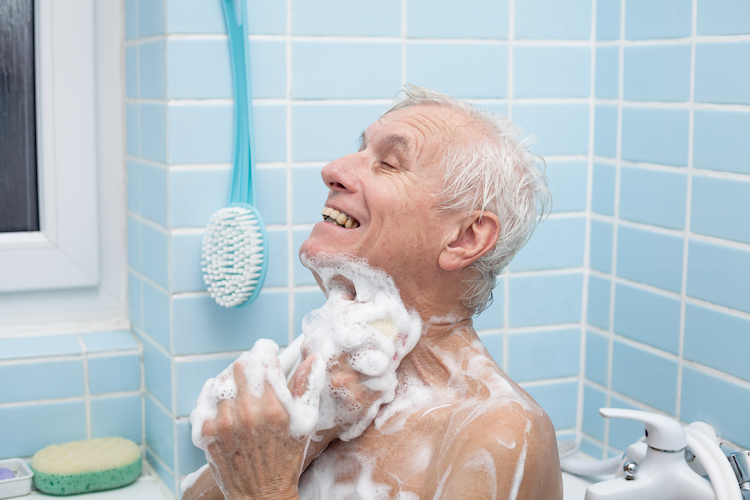Elderly Bathing and Hygiene Guide
As we get older, the simple act of bathing goes beyond simple cleanliness, becoming a cornerstone of dignity, comfort, and overall well-being. Yet, as straightforward as it may seem, the task of maintaining proper hygiene can become fraught with challenges for our elderly loved ones.
Even aside from the challenges of ageing itself, conditions such as dementia, reduced mobility, visual impairments, and arthritis not only alter their daily lives but also transform bathing—a once routine activity—into a task that demands meticulous attention, adaptation, and care.
This guide goes into the heart of elderly bathing, exploring the needs of those tackling the complexities of age and health conditions. We aim to equip caregivers, healthcare professionals, and families with the knowledge to enhance the bathing experience for their elderly charges, ensuring safety, preserving dignity, and encouraging independence.
From walk-in baths for the elderly to the supportive presence of bath seats, lifts, and steps, we explore a range of solutions designed to meet multiple needs.
What Is Personal Hygiene for the Elderly?
Personal hygiene for the elderly covers a range of practices aimed at maintaining cleanliness and promoting overall health and well-being. This includes regular bathing, oral hygiene, hair and nail care, and proper wound care when necessary. For many, achieving this level of personal hygiene may require the use of bathroom aids for elderly and disabled users, like bath seats, walk-in baths or bath lifts for the elderly, alongside personalised care plans to address their specific needs and abilities.
Download Or Request Your Free Walk-In Bath Guide
Understanding the Unique Bathing Needs of the Elderly
Bathing isn’t just about cleanliness, of course. It’s a critical aspect of personal hygiene that directly impacts the overall well-being and quality of life of older adults. As people grow older, their ageing skin becomes more delicate, their mobility can decrease, and their senses may not be as sharp as they once were. These changes require a thoughtful approach to how we assist them with their bathing needs.
Safety first: Walk-in baths for the elderly
One of the main considerations for elderly bathing is safety. Traditional bathtubs pose a significant risk of slips and falls, which can lead to severe injuries. Walk-in baths offer many benefits for the elderly, as they’re designed to reduce these risks, offering a safer alternative. These specially designed baths allow easy access, often featuring built-in seats, non-slip flooring, and handrails to ensure stability and comfort during bathing. By incorporating walk-in baths into bathroom design, caregivers can significantly reduce the risk of accidents, making bathing a safer, more enjoyable experience for the elderly.

Enhancing independence: Bath seats and lifts
Maintaining independence for as long as possible is crucial for the self-esteem and mental health of older adults. Bath seats and bath lifts for the elderly are invaluable aids in achieving this goal. Bath seats provide a secure, stable place to sit while bathing, reducing the risk of slips and falls and making it easier for those with limited mobility to bathe independently. Bath lifts take this a step further, gently lowering and raising the individual into and out of the bathtub, thereby enabling those who would otherwise be unable to enjoy a bath to do so safely and with minimal assistance.
Accessibility and comfort: Bath steps for the elderly
For many seniors, even the small step into a walk-in bath can be a challenge. Bath steps for the elderly are designed to make this process easier, offering a stable platform that reduces the height difference. These steps, combined with handrails, can make all the difference in transforming a potentially hazardous activity into a safe, manageable part of their routine.
A considerate approach
When addressing the bathing needs of the elderly, it’s important to consider not just the physical aspects but also the emotional and psychological ones. The changes that come with ageing can be difficult to accept, and the need for assistance with such a private activity as bathing can affect a person’s sense of dignity and independence.
It’s essential to approach the topic and the activity itself with sensitivity, respect, and a commitment to maintaining the individual’s dignity. This means engaging in open, honest conversations about their preferences, needs, and concerns and being flexible and adaptive in meeting these needs.
Contact us today by calling us or using our online contact form to discuss how we can assist you in making these critical improvements. Together, we can improve the well-being of the elderly, providing them with the care and respect they deserve.
Let’s create a bathroom space that offers comfort, safety, and independence, tailor-made to meet the unique needs of your loved one.
What Personal Care Hygiene Tasks are Needed for the Elderly?
Personal care hygiene tasks for an elderly client include bathing or showering, oral care, hair care, nail care, and regular changing of clothing. Ensuring access to bathing aids such as walk-in baths, shower chairs, and bath lifts for the elderly can significantly aid in maintaining these hygiene tasks. Plus, incorporating routine dental care and assistance with grooming can support comprehensive personal hygiene.
Elderly Bathing and Dementia
Bathing can become a particularly challenging task for those living with dementia due to the cognitive and sensory changes they experience. The process, which once might have been straightforward and routine, can turn into a source of confusion and distress. However, with understanding, patience, and the appropriate use of aids for the elderly, caregivers can create a bathing routine that supports the dignity and comfort of those with dementia.
Creating a familiar and safe environment
Familiarity is key when designing dementia-friendly bathrooms. Installing a walk-in bath that’s not just designed for the elderly but that matches the bathroom aesthetics they are used to can significantly reduce the stress associated with stepping over a tub’s edge, which can be both physically daunting and cognitively confusing. The safety features of these baths, such as non-slip surfaces, low thresholds, and handrails, can also help reduce anxiety around bathing, making the process safer and more comfortable.
Maintaining routine and dignity
Dementia can affect a person’s sense of time and routine, which makes establishing a consistent bathing schedule crucial. This routine helps create a sense of familiarity and security. When introducing bathing aids like bath lifts, it’s important to do so gradually, allowing the person with dementia to become accustomed to these new objects in their environment. Maintaining their dignity throughout this process is vital, so the choice of bathing aids should prioritise ease of use and comfort, ensuring the individual’s privacy and independence are respected as much as possible.
Bathing Solutions for Elderly Wheelchair Users
For the elderly who use wheelchairs, the task of bathing presents unique challenges that require thoughtful solutions. Mobility limitations can make traditional bathing setups impractical and unsafe, requiring specialised bathing aids and adaptations.

Integrated solutions for accessibility
Creating an accessible bathing space often involves more than simply adding equipment. It needs a holistic approach to design. Innovations such as doorless walk-in showers eliminate the need for difficult transitions, while textured flooring reduces slip hazards, making the bathroom safer for wheelchair users. Adjustable shower heads and easy-to-reach controls enhance independence, allowing for a comfortable and autonomous bathing experience. There are many types of showers designed for the disabled or elderly, so be sure to know your options.
Customised comfort and safety features
Comfort in the bathroom means creating a sense of security and relaxation. Therapeutic bath modifications can include temperature-controlled water that ensures a soothing experience without the risk of burns. Seats integrated directly into the shower area provide stability and reduce physical strain during bathing, catering specifically to the needs of those with mobility issues.
Independence through innovative design
Features like voice-activated technology for water temperature and flow control can offer a hands-free operation, making it easier for those with limited mobility to manage their bathing experience. Customisable bathroom layouts that consider the individual’s specific range of motion and strength can lead to easier access and use.
Improving Bathing Safety for the Visually Impaired
Creating a safe and accessible bathroom environment for the elderly and visually impaired can be challenging and requires an approach that goes beyond the standard solutions. Recognising the unique challenges faced by those with visual impairments is the first step to ensuring their safety and comfort during bathing.
Tactile and auditory modifications for increased independence
Applying tactile cues in the bathroom can significantly help those with visual impairments. Textured strips or mats can guide them safely to and around the bathing area. Similarly, controls and taps with tactile markers can help users independently adjust water temperature and flow.
Technology that provides auditory feedback can be invaluable, too. Devices that announce water temperature or emit a sound when a certain level is reached ensure safety and prevent scalding. Similarly, audible alerts for soap dispensers and other bathroom necessities can mean a smoother, more autonomous bathing experience.
Specialised bathroom fixtures and fittings
Using high-contrast colours for bathroom fixtures, such as the toilet seat, grab bars, and the edges of bath steps or shower entrances, can make them more discernible for individuals with limited vision.
Consider installing a shower system designed with the visually impaired in mind. Features might include hand-held showerheads with easy-to-feel buttons for controlling water flow and temperature and shower stalls with built-in seats and open designs to eliminate the need for doors, reducing potential navigation obstacles.
Bathing with Arthritis: Managing Pain and Mobility
Arthritis can transform simple daily activities into challenging tasks, with bathing being no exception. The good news is that there are strategies and bathing aids to manage arthritis-related pain and mobility issues, ensuring a safer and more comfortable bathing experience.
Ergonomic bathroom aids for enhanced support
Incorporate fixtures that are designed with arthritis sufferers in mind. Taps with lever handles, for example, are easier to operate than traditional knobs. Shower heads that can be adjusted with minimal effort and have easy-to-press buttons for changing water flow patterns can significantly reduce pain and discomfort.
Walk-in baths and wet rooms can also be amazing for those with arthritis, providing easy access without the need to climb over high tub edges. The built-in seating and handrails offer stability and comfort, minimising strain on joints. For shower users, consider a design that eliminates steps entirely.
Implementing Safety Measures
Creating a safe bathing environment for the elderly, particularly those with specific health conditions or mobility challenges, requires a meticulous approach to safety. This includes a range of safety measures and adaptations aimed at minimising risks and enhancing the overall well-being of older adults during their bathing routine.
Comprehensive bathroom safety overhaul
Beyond the conventional aids, it’s essential to think creatively about reducing potential hazards in the bathroom. This includes installing temperature control devices to prevent scalding, applying non-slip surfaces within the tub or shower and throughout the entire bathroom floor, and ensuring adequate lighting to improve visibility for all, including those with visual impairments.
Consider using weighted shower curtains or doors that offer additional stability and prevent water spillage, which could lead to slips. Customisable shelving within easy reach can prevent overreaching or bending that might compromise balance, particularly for those with arthritis or who use mobility aids.
Technology for preventive measures
Integrating smart home technology, such as voice-controlled lighting, automated temperature adjustments, and digital showers, can offer significant benefits. For those with cognitive impairments or physical limitations, being able to control their environment without physical switches or knobs can make a substantial difference in their safety and autonomy.
Creating a Comforting Bathing Experience
Focusing on the atmosphere and sensory aspects of the bathroom can significantly contribute to a positive, relaxing experience. Let’s look at how caregivers can enrich the bathing routine, making it a highlight of the day rather than a task to dread.
Engaging the senses for relaxation and comfort
Incorporating music or nature sounds can transform the bathing environment into a tranquil retreat. For those with visual impairments, auditory cues can also offer a sense of space and calm, making the bathing experience more enjoyable and less disorienting.
Using familiar and pleasant scents can also have a calming effect, especially for those with dementia who may find comfort in the familiarity. Fragrance-free options are crucial for those with sensitivities, ensuring the environment is welcoming without being overwhelming.
Ensuring a safe and nurturing environment
A clean, organised bathroom helps to lower risks and simplify navigation, which is particularly important for those with visual or mobility impairments. Cleared pathways and easily accessible essentials contribute to a stress-free experience.
For many, especially those with cognitive impairments, bathing can be a distressing experience. A supportive presence, whether through physical assistance or verbal encouragement, can provide comfort. Acknowledging and responding to the emotional state of the elderly person turns the bathing process into an opportunity for bonding and reassurance.
Maintaining Dignity During Bathing
Ensuring the dignity of the elderly during bathing is incredibly important, touching on the very essence of compassionate and respectful care. This is all about acknowledging and supporting the person’s sense of self-respect, privacy, and independence. By thoughtfully incorporating walk-in baths and other hygiene aids into the bathing routine, caregivers can significantly enhance the safety and comfort of the elderly while simultaneously preserving their dignity.
A sense of normalcy
The introduction of bathing aids should aim to improve comfort without making the bathroom feel clinical. Walk-in baths and bath seats for the elderly can be selected in styles that blend seamlessly with the home’s existing decor, contributing to a sense of normalcy and personal space.
Incorporating familiar items like their preferred bath products or towels can help maintain a connection to their routines before requiring assistance.
Encouraging participation
Even with mobility challenges, the elderly can often participate in their care to some extent. Allowing them to direct certain aspects of the bathing process, whether it’s choosing the water temperature or washing areas they can reach, creates a sense of control and involvement. Bath lifts that are operated by the user, for example, can offer a sense of agency, while strategically placed bath steps for the elderly can provide an opportunity for physical engagement in the process, according to their ability.
Ensuring privacy and comfort
Privacy is a crucial aspect of maintaining dignity. Even when assistance is necessary, efforts should be made to preserve privacy as much as possible. This might mean positioning bath seats and lifts to allow for discreet use. Providing a robe or towels for coverage before and after bathing can also significantly affect how comfortable and respected the person feels.
Importance of Regular Dental and Personal Care
Traditional oral hygiene practices can become difficult for anyone with mobility issues or health conditions.. Ergonomic or electric toothbrushes with large handles can help maintain their dental care routines independently. Water flossers or floss holders can offer easier alternatives to traditional flossing, ensuring thorough cleaning without the need for fine motor skills that might be impaired by arthritis or other mobility-restricting conditions.
Improved Elderly Care with Tailored Bathroom Solutions
Understanding the unique challenges faced by elderly individuals, especially those with mobility issues and other impairments, is the first step in creating a supportive bathroom environment. By investing in the right aids and making necessary adaptations, we can significantly improve their quality of life.
However, recognising the need for professional guidance in choosing and installing these aids is equally important.
Take the next step towards optimising the bathroom for the elderly loved one in your life. Our compassionate team of bathroom specialists in the UK is dedicated to finding the ideal solution for your needs. There’s a reason why we’re the UK’s #1 installer of mobility bathroom suites and accessories. With our expertise, we can help you modify your bathroom to ensure that showering and bathing become not just safer but a truly enjoyable part of the day for the older person in your care.
Age Care Bathrooms has been designing and constructing mobility bathrooms for more than 30 years. Call our team of bathroom specialists or fill out our online form, and we’ll help you choose the bathroom that meets your needs.












